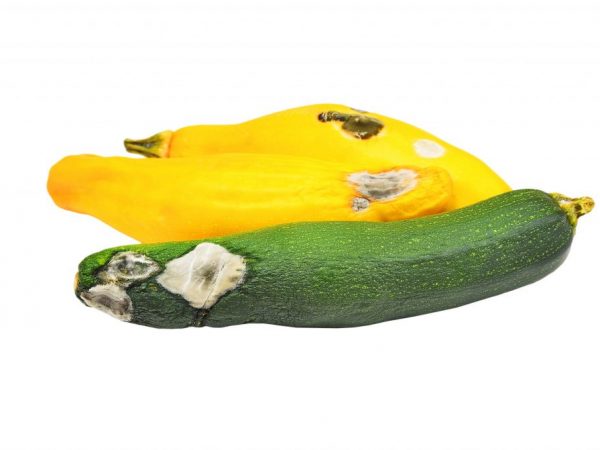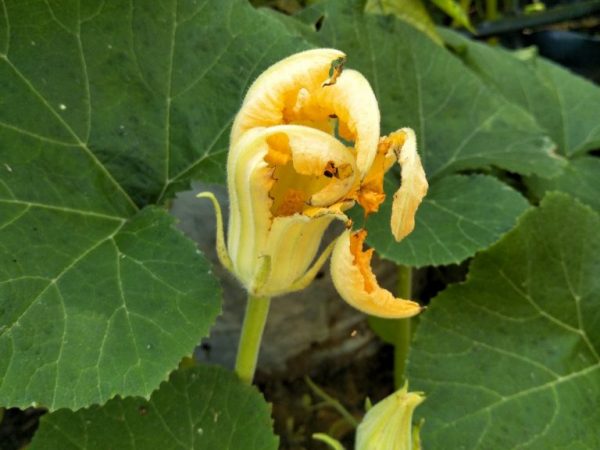Causes of rotting zucchini
When growing zucchini, gardeners face many challenges. One of the most common is rotting of various organs on the plant. To solve the problem, you need to know why zucchini rot and how to deal with it.

Causes of rotting zucchini
Weather
Bad weather is one of the most common causes of rotting not only of the ovaries, but also of other parts of the plants in the garden. Zucchini is a thermophilic crop. In conditions of high humidity and cold temperatures, it begins to rot. In the cold and dampness, the plant's immunity weakens, it is unable to form ovaries, therefore it begins to get rid of them. In cool and cloudy weather, the plant suffers from a lack of pollinating insects. Non-pollinated flowers begin to rot, and the vegetable gets rid of them.
It will be possible to eliminate the problem of waterlogging if you install a film protection over the landings. This technique is effective in a rainy summer.
Lack of nutrients
This plant, belonging to the pumpkin family, reacts sharply to the lack of boron and iodine. With their deficiency, the bushes begin to rot and shed their buds.
Fixing this problem is easy. For this, the planting is sprayed with a solution of boric acid (2 g of the substance is diluted in 10 l of water). It is worth using liquid complex fertilizers, which include this microelement.
Due to the lack of iodine, the zucchini not only rot and shed flowers, but also bear poor fruit. To avoid such negative consequences, it is required to treat the bushes with a solution of potassium iodide.
Density of plantings
If the ovaries rot in zucchini, the reason for this may be a violation of the planting scheme. The plant grows large and grows quickly, so it needs a lot of space on the site. When the plantings are thickened, rotting begins not only of the ovaries, but also of other parts - stems, leaves.
As a preventive measure, old, yellowed and dried leaves must be removed, and weeds must be removed in time.
The optimal planting pattern is 60 × 50 cm. At this distance, they will fully develop and will not suffer from a lack of light and oxygen.
Powdery mildew
One of the most dangerous diseases of this culture is powdery mildew. Signs of damage: the appearance of a whitish bloom in the form of flour, first on the surface of leaves, stems, then on inflorescences, small ovaries. The fungus spreads quickly. After a while, white spots turn red, then turn black, causing rotting of leaves, inflorescences and ovaries.
Affected specimens should be removed from the site and burned. Ailing plants that can still be saved are treated with copper-containing preparations - copper sulfate or Bordeaux mixture. All damaged parts are removed before spraying. Processing is carried out no later than a month before the planned harvest.
Top rot

Lack of potassium in the soil can lead to plant death
A fungal disease called apical rot first affects the foliage, then spreads to young ovaries and causes them to massive rot. All affected parts first deform, become wrinkled, then rot and fall off.
The main reason for the appearance of top rot on a squash bed is a lack of potassium in the soil. To eliminate the problem, the bush is fertilized with potassium nitrate or another preparation, which contains this trace element.
To prevent and increase the plant's resistance to this sore, a weakly concentrated iodine solution is introduced into the soil. Such feeding increases the resistance of plants to other viral and bacterial infections, which eliminates the risk of rotting of the underground and aboveground parts. The solution consists of 3 drops of iodine in 10 liters of water. The bushes are spilled under the root with a working solution, or the aboveground part is irrigated.
Excess watering
Despite the fact that zucchini is a moisture-loving crop, frequent watering is contraindicated for it. Vegetables react to an excess of moisture by decaying all organs and mass discharge of inflorescences. The same reaction should be expected when watering the bushes with cold water. To eliminate the problem, you should adjust the watering in the garden and carry it out only as the soil dries out. In rainy summers, watering is minimized.
Plants are watered by sprinkling, because strong pressure can lead to leaching of the roots and the death of the entire bush. Water is poured under the root, avoiding moisture on the leaves and ovaries.
To prevent rotting of the root system, due to which the aerial part rotted, it is important to regularly carry out the procedure for loosening the soil. This will increase its aeration and prevent moisture stagnation in the soil.
Violation of the rules of crop rotation
Another reason vegetables rot is a violation of crop rotation rules. This plant should not be planted in the same place, because there is a great risk of contracting diseases that provoke the appearance of rot.
Also, you should not plant zucchini in an area where pumpkin, squash or cucumbers previously grew. Planting a pumpkin crop on such a site is allowed no earlier than 4 years after their cultivation.
Useful Tips
If there is a problem of rotting zucchini, action is required, focusing on the situation:
- If only the tip of the fruit is affected by rot, it is carefully pinched off to a healthy part and burned. The cut off place will tighten, become dense, corky, and the fruit itself will continue to grow.
- Completely rotten ovaries are immediately removed, because rot can move to the area of the stalk and provoke rotting of the stem.
- In a rainy summer, in order to avoid the appearance of rot on the bushes, it is better to remove old foliage, because it prevents access to light and good ventilation.
- To protect the already set fruits in damp weather, a cardboard or plank is placed under each specimen that comes into contact with the soil.
- If the embryo rots, it is immediately removed, because nothing will grow out of it, moreover, it is a good breeding ground for pathogenic microflora and infecting healthy organs.
- When watering the beds, it is necessary to avoid getting water on the leaves and ovaries. The most suitable drip irrigation, which completely eliminates the risk of wetting the stems, leaves, ovaries and their subsequent rotting.
- Regular inspection of the bushes will help to avoid the development of diseases. The affected parts are immediately removed and burned, and the cut areas are sprinkled with wood ash.
- All wilted flower buds are cut off in time, because over time they will rot and become carriers of infection.
Conclusion
There are many reasons why zucchini begin to rot, but if all planting rules, care and growing requirements are followed, this problem can be avoided. This will help simple and useful advice from experienced gardeners.

